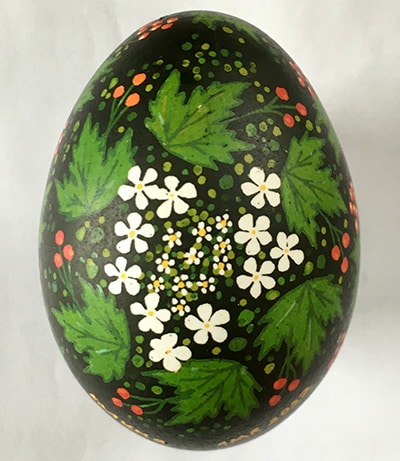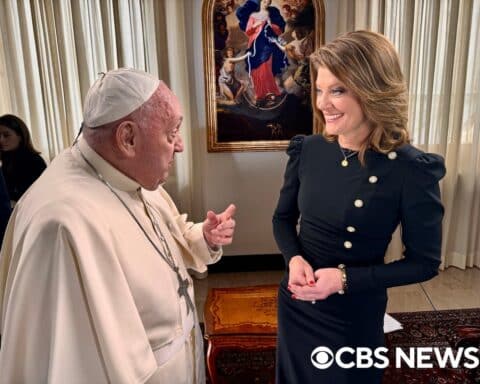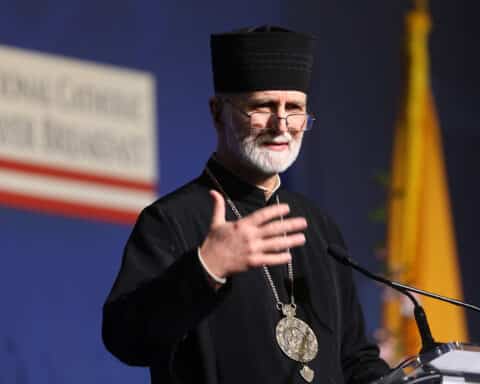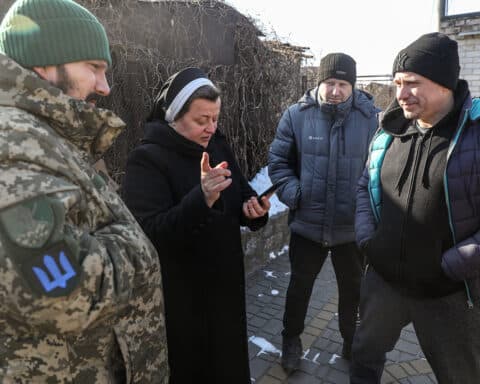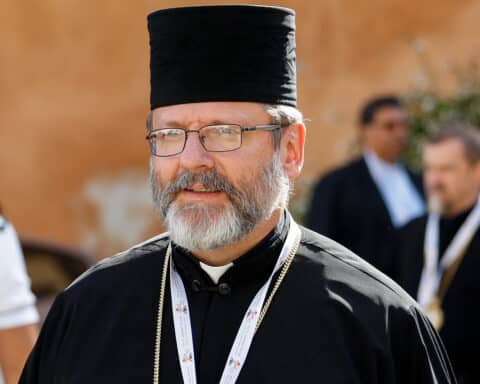For more than 20 years, Ginette Nalevanko Simpson of New Alexandria, Pennsylvania, has set up at a local restaurant during Lent to demonstrate the art of pysanky, the traditional decorated Ukrainian eggs.
She sells them to raise money for her tiny parish, the Nativity of the Blessed Virgin Mary Ukrainian Catholic Church that her grandparents helped build for their immigrant community.
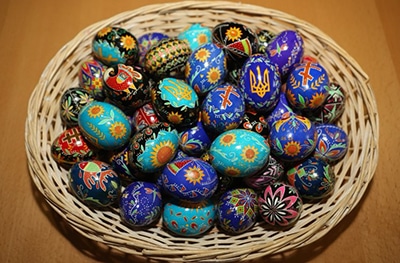
That project expanded this year when Simpson and the parish administrator, Father Yaroslav Koval, earmarked a portion of the fundraiser for Smile of the Child, a home for special needs orphans and young adults in western Ukraine, the priest is from. His two other parishes have supported the home for years.
Simpson joined countless pysanky artists worldwide who wrote their eggs (writing is the correct term for creating pysanky and icons) to support people in war-torn Ukraine.
The colorful eggs originated in pre-Christian legends that revered eggs as symbols of birds that were the only creatures who could get close to the sun god. After the introduction of Christianity, they represented the Easter message of the resurrected Christ and Mary’s tears spotting eggs with brilliant colors as they fell.
Another legend in the Carpathian Mountains linked the fate of Ukraine and the world with the hands of those who write pysanky. It was said that every year a horrible monster that’s chained to a cliff sends out messengers to see how many eggs are being decorated. If they report that there are few, the monster’s chains loosen, and evil is released into the world. If many are being made, the chains are tightened, and good triumphs over evil for another year.
This year, pysanky eggs have become for many a labor of love and a symbol of support for the victims of war.
“Every year, I make about 90 eggs for four days, but I sold almost all of them the first evening,” Simpson said. “I made 25 more that evening and overnight at home. By the third and fourth day, I had to bring in 35 eggs from my own collection.”
The percentage from sales, plus outright donations, raised more than $2,000 for the orphanage.
“People were truly compassionate,” said Simpson, a third generation pysanky artist. “Several people dropped in $100 bills, and little kids were emptying change from their pockets.”
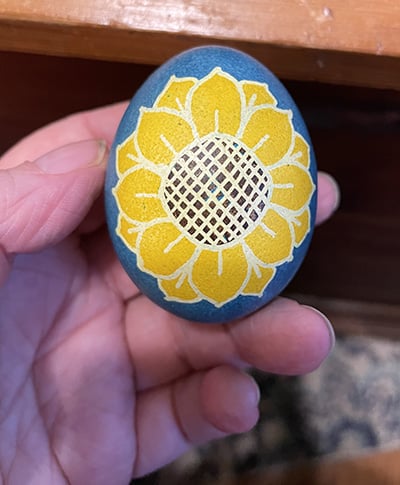
Janet Weidemann of Tallahassee, Florida, has no ethnic connection to Ukraine; she learned how to make pysanky from internet instructions. She’s been giving away one egg every day during Lent in exchange for a donation to a charity that’s sending aid.
“I pray for peace for Ukraine while I’m doing this,” said Weidemann, a Catholic convert. “I didn’t start out seeing this as anything but artistic, but the more I’ve done it, the more I became aware of the spiritual aspects.”
Daena Diduck of Calgary, Alberta, Canada, has been writing pysanky since first grade. Her maternal and paternal ancestors immigrated from Ukraine in the late 1800s or early 1900s, and her childhood was rich in ethnic traditions. She attends a Ukrainian Catholic church.
She and her friend, Cathy Wilson Reitz, raffled off their own eggs and other donated pysanky to benefit the Ukraine Humanitarian Appeal and the Cobblestone Freeway Foundation, a cultural tour group that shifted its focus to supporting Ukrainians.
“Each artist made whatever design they wished,” Diduck said. “Many made pysanky with doves and with blue and yellow, the colors of the Ukrainian flag.”

Heather Nicole Davis of Millville, New Jersey, used similar colors and specific Ukrainian designs for fundraising pysanky. One was raffled off in March to benefit the International Rescue Committee.
Davis is a third-generation Ukrainian who learned to write pysanky when she was 8. She works with eggs of all sizes, from quail to ostrich. The designs are traditional patterns, and some have crosses and other symbols of prayer, thoughts and comfort.
“In instances like we are seeing in Ukraine, the designs can say, ‘praying for you, sending you peace and sending you love,'” Davis said. “You can write that on your egg and have that speak for you.”
Amelia Randich of Scranton, Pennsylvania, raised money by holding pysanky workshops at the University of Scranton, where she teaches. Her maternal ancestors were among the first wave of Ukrainian immigrants to settle in Chicago. In her grandmother’s generation, the family converted from the Ukrainian Greco Catholic Church to Roman Catholic.
“I’ve been writing pysanky for almost 35 years,” Randich said. “I used to write them only during Lent, but now I write them all year long. It’s a form of meditation, and there are special intentions when I write for people who are ill. This Lent, I’m thinking about the Ukrainians and putting many prayers into my pysanky.”
Randich created a special design with leaves, summer flowers and autumn berries of the kalyna plant on a black background. It was inspired by the anthem of the Ukrainian Sich Riflemen of World War I and the Ukrainian Insurgent Army of World War II.
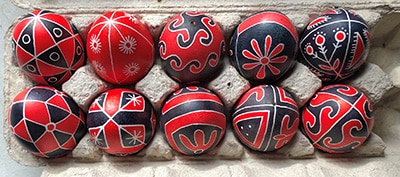
Jonathan Ball of Banff, Alberta, Canada, took a workshop and wrote one egg in 2019 and two in 2020 before deciding that it was a perfect activity during the pandemic.
When Russia invaded Ukraine, he said, “I wanted to make a donation and do something in a way that I could come to grips with that anxiety, that constant stream of the images of war.”
Ball sold his pysanky to benefit the Canadian Red Cross’s fund for Ukraine. The eggs also raised awareness, he added, of a country with a proud heritage.
“The eggs, although fragile objects, are powerful symbols of a strong and enduring culture,” he said.
Ball wrote pysanky during a 30-hour online egg-a-thon that brought together 100 artists from 14 countries.
“We wrote eggs while holding Ukraine and her people in our hearts and minds,” he said.
The work of these and many other artists can be found on the Facebook group Pysanky For Ukraine.
Maryann Gogniat Eidemiller writes from Pennsylvania.


